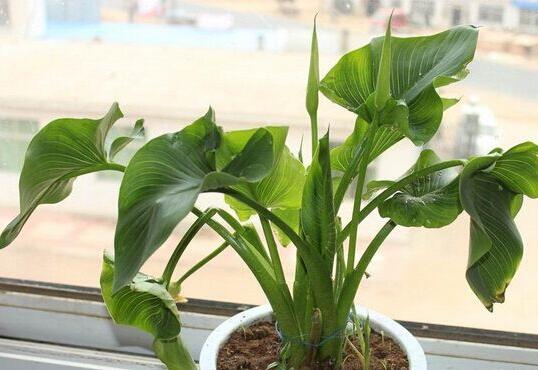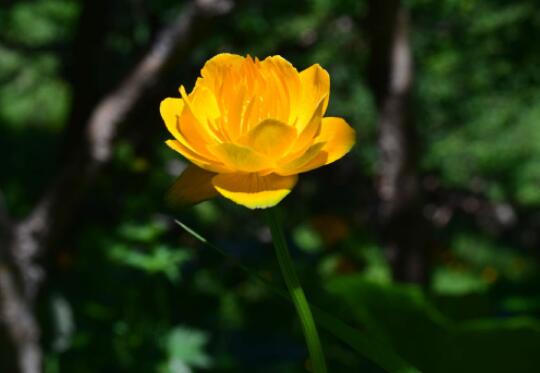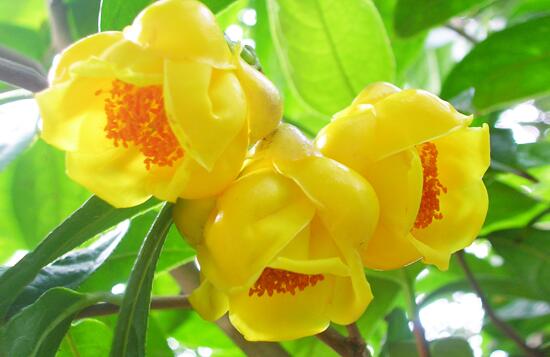How to raise sea taro flowers, culture methods and matters needing attention / shading
Sea taro is a world-famous flower plant, which has high ornamental value. It is cultivated in many parts of our country, but if we want to raise it well, there are many places that need to be paid attention to. About how to grow sea taro flowers? What are the culture methods and matters needing attention of sea taro flowers? Next, the editor will take you to learn about it.
First, how to grow sea taro flowers and understand their habits

If we want to know how to raise taro flowers, we must first understand its growth habits. This plant likes a warm and humid environment, has a certain shade tolerance, and is more afraid of strong light, so we should do a good job of shading when we breed. In addition, daily water and fertilizer management also needs attention.
II. Culture methods and matters needing attention of sea taro flowers
1. Humus soil
When we cultivate sea taro flowers, we first need to choose soil, which is a step to lay a good foundation, so we must choose the most suitable one. Generally, it is best to choose loose and fertile humus soil, which has good drainage and air permeability, so that plants can better absorb nutrients and are not prone to stagnant water.
two。 Fertilization, once a week during the growing period
Fertilizer is one of the main nutrients in the growth process of sea taro flowers, especially after entering the growth period, its demand for water is very high, basically every other week, so that its leaves can grow big. However, there is one thing we should pay attention to when fertilizing, that is, the fertilizer must be diluted with water first, if the concentration is too high, it will burn the plant.
3. Moisture would rather be wet than dry
Amorphophallus likes to grow in a moist environment, so we should water it frequently when raising it, because the dry environment is very disadvantageous to its growth. In cultivation, we should spray more water around it, increase the humidity of the air, and maintain the principle that it would rather be wet than dry in its growing season, but it should not be watered too much, if it causes stagnant water, it will easily lead to root rot, so we should master a degree.
4. Light, avoid strong light
The sea taro flower is not resistant to strong light, so when we breed it, it is best to put it in a place of sunlight scattering to avoid direct sunlight, especially when the light is relatively strong from June to October, we have to shield it from 50% to 70% of the sun. So as not to burn it with too much light.
5. Pest management
In the process of cultivating sea taro flowers, if we are not careful enough, we can easily let diseases and insect pests enter while we are not careful. this kind of problem is very harmful to plants, so we must pay special attention to it. If we find it, we should deal with it as soon as possible. For specific treatment methods, you can refer to the article on pest and pest control of sea taro flowers, which is introduced in detail.
What if the leaves of sea taro turn yellow, apply thin fertilizer / replenish water / shade
The sea taro flower is a perennial herb of the Araceae family, which is highly ornamental and can be seen all over the country. However, if the plants in the United States turn yellow, it will also affect their overall aesthetic feeling. What about the yellowing leaves of the sea taro flowers? What is the reason and how to solve it? Next, the editor will take you to learn about it.
First, sea taro leaves yellowing how to do, find the reason
Want to know the sea taro leaves yellowing how to do, first of all, we have to find the reason, to know what is the cause of the leaves yellowing, so that we can carry out targeted treatment. Such as improper watering, insufficient humidity, diseases and insect pests are the causes of this phenomenon, as for how to solve, described in detail below, let's take a look at it.
Second, the reasons for the yellowing of taro leaves (with solutions)
1. Improper fertilization
Fertilizer is one of the main nutrients in the growth of sea taro flowers. If we apply too little fertilizer or the concentration of fertilizer is too high, it will cause the leaves of sea taro flowers to turn yellow. If it is fertilized too little, it will turn yellow due to lack of nutrients, and if the fertilizer concentration is too high, it will burn the plant and cause yellowing.
Solution: the demand for fertilizer in the growth process of sea taro is very high, especially after entering the growth period, its demand for water is very high, basically every other week to apply fertilizer, so that its leaves can grow big. However, the concentration of fertilizer should not be too high when fertilizing, and must be diluted with water before application. If the concentration is too high, it is easy to burn the plant.
two。 Water deficiency
The sea taro flower this kind of plant prefers the warm and humid environment, so the water is very important to it, but how much is watered is the point that we need to pay attention to, if it is watered too much, it will cause its root system to be unable to breathe. as a result, the leaves yellowed, and if too little watering will cause the plant to dry and yellowing.
Solution: if we cause stagnant water when watering taro flowers, we must clean up the stagnant water in time, as long as the problem is generally not very big. If the leaves of taro flowers turn yellow because of drying, we can spray more water on the leaves to maintain the humidity of the environment.
3. The light is too strong.
Amorphophallus likes to grow in a warm environment and is less resistant to direct sunlight. In the process of breeding it, if the light is too strong, it is easy to burn the plant, resulting in the problem of yellowing of taro leaves.
Solution: in the process of cultivating taro flowers, it is best to put them in a place of sunlight scattering to avoid direct sunlight, and when the summer light is relatively strong, we can keep them indoors in the semi-shade. so as not to burn the plant and cause its leaves to turn yellow.
4. Diseases and insect pests
In the process of the growth of sea taro flowers, if we do not maintain properly, it is easy to appear some bad phenomena such as diseases and insect pests, this kind of problems do great harm to the plant, not only affect its ornamental, but also cause the leaves of sea taro flowers to turn yellow and dry.
Solution: when there are diseases and insect pests and other problems, we must deal with them in a timely manner. If the time is prolonged, the damage to the plant will be great, and it will be troublesome to deal with it. For specific prevention and control methods, you can refer to the article on pest control of sea taro flowers. Here, the editor will not repeat it.
Culture method and picture appreciation of Ping an tree
Due to the excellent ornamental quality and the fragrance of correcting odor and purifying the air, Ping'an tree continues to be popular despite its high price. The bark of Ping an tree can be used as medicine, which has the effects of dispelling wind and cold, relieving pain and removing blood stasis, activating blood circulation and invigorating the stomach, which can be said to be very friendly to human beings. So, what is the breeding method of Ping an tree?
The cultivation method and picture appreciation of Ping an tree-
[plant archives]-
English name: ping an Tree (Real name Lanyu Cinnamon)
Scientific name: Cinnamomum kotoense
Aliases: Hongtouyu cinnamon, Hongtoushan cinnamon, Fanglan mountain cinnamon, big leaf cinnamon, Taiwan cinnamon and so on.
Family: Cinnamomum of Cinnamomum
Genus: Alocasia
Distribution of origin: Lanyu Island, Taiwan, China
Morphological features: small evergreen trees, dignified tree shape, yellowish brown bark, large leaves, 10 cm to 22 cm long, 5 cm to 8 cm wide, bright green surface, metallic luster, back grayish green, petiole about 1.5 cm long, reddish brown to brown. It is not only a beautiful potted foliage plant, but also a very beautiful landscape tree.
The growth habits of Ping an trees-
Safe trees like warm, humid, sunny environment, like light and shade, like warm heat, no frost and snow, foggy and hot places, do not tolerate drought, stagnant water, cold and dry air. The safe tree should be cultivated in acid sandy soil which is loose and fertile, well drained and rich in organic matter.
Temperature and water management of safe trees-
The suitable temperature for the growth of Ping an tree is 20 ℃ to 30 ℃. If the frost lasts for more than 5 days, the bark can be cracked and the branches and leaves will wither. When the temperature is more than 32 ℃ in midsummer, Ping an trees should be given shelter and foliar spraying measures. It is better to keep the environmental relative humidity of Ping an tree above 80%. It is often necessary to spray water on the leaf surface of Ping an tree and its surrounding environment during the high temperature season in summer or when the air is relatively dry in autumn. Control watering after autumn, spray more and water less in winter. If there is water in the basin soil, it will easily lead to the yellowing of Ping an trees and the death of rotting roots.
Soil and fertilizer management of Ping an trees-
Safe trees should adopt fertile acid culture soil or rotten leaf soil with loose ventilation, unobstructed drainage and rich organic matter. If the basin soil is hardened or the pH value is more than 7.5, the leaves of Ping an tree will turn yellow, seriously grow badly, decrease the sprouting ability, and even shorten the life span. Therefore, small safe trees should change their pots once a year, while large ones can change soil once every two years and loosen the soil once a month during the growing season. Ping an tree needs a large amount of fertilizer, from mid-spring to early autumn, can be applied once a month thin cake fertilizer water or fertilizer alum water and so on. After autumn, phosphorus and potassium fertilizer should be applied twice in a row to increase the cold resistance of Ping an tree.
Light management of Ping an tree-
Ping an tree needs better light, but it is more shady. 3-5-year-old trees grow fast under shade conditions, while 6-10-year-old trees require sufficient light. After entering the summer, if the light is too strong, it is easy to cause the leaves to turn yellow and reduce its due ornamental value.
Conclusion: this article comes to an end, and its contents are closely related to the breeding methods of Ping an trees. It is expounded in detail from the aspects of temperature and humidity, light, nutrition, soil and so on, hoping to provide some theoretical help for the flower friends who cultivate Ping an trees.
[related recommendations]
- Prev

How to raise the golden lotus, the culture methods and precautions of the golden lotus / avoid bright light
Trollius is a plant of the genus Trollius of Ranunculaceae, which is highly ornamental and is cultivated in all parts of our country, but there are still a lot of things that need to be paid attention to if we want to raise it well. About how to raise the golden lotus? What are the culture methods and matters needing attention of Golden Lotus?
- Next

How to propagate golden scented tea, two propagation methods of golden scented tea (cutting / sowing)
Golden scented tea, also known as yellow camellia, as its name, it has a golden color, crystal clear, looks very beautiful. Because of the beauty of golden scented tea, but also because of its strong efficacy, it is multiplied in large numbers, so how to reproduce golden scented tea? According to the editor, there are two common propagation methods of golden scented tea, one is cutting.
Related
- Fuxing push coffee new agricultural production and marketing class: lack of small-scale processing plants
- Jujube rice field leisure farm deep ploughing Yilan for five years to create a space for organic food and play
- Nongyu Farm-A trial of organic papaya for brave women with advanced technology
- Four points for attention in the prevention and control of diseases and insect pests of edible fungi
- How to add nutrient solution to Edible Fungi
- Is there any good way to control edible fungus mites?
- Open Inoculation Technology of Edible Fungi
- Is there any clever way to use fertilizer for edible fungus in winter?
- What agents are used to kill the pathogens of edible fungi in the mushroom shed?
- Rapid drying of Edible Fungi

